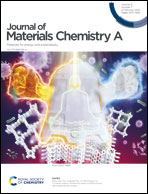Surface reactions between LiHMDS, TMA and TMP leading to deposition of amorphous lithium phosphate†
Abstract
This work reports on the atomic layer deposition process combining lithium hexamethyl disilazide (LiHMDS) and trimethylphosphate (TMP), and studies the impact of adding a trimethylaluminum (TMA) pulse to this process. When only minute traces of aluminum are incorporated, the deposited layer becomes amorphous instead of crystalline. The TMA–TMP interaction plays a key role in this process and is revealed by time-resolved full-range quadrupole mass spectrometry. It is hypothesized that the interaction of unreacted –OCH3 groups with TMA and the formation of Li4P2O7 units lead to higher growth and structural changes as compared to the phosphate process without TMA. The conformal deposition of lithium-containing phosphates may find applications in modification of electrode–electrolyte interfaces in lithium-ion batteries. This is demonstrated in a half-cell. The amorphous mix of Li4P2O7 and Li3PO4 units in the films grown with TMA benefits the conductive properties of the material: an ionic conductivity of 1.47 ± 0.09 × 10−7 S cm−1 at 30 °C is achieved, with an activation energy 0.58 ± 0.02 eV.



 Please wait while we load your content...
Please wait while we load your content...